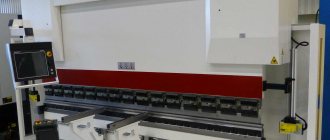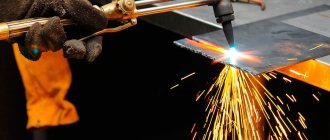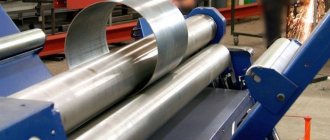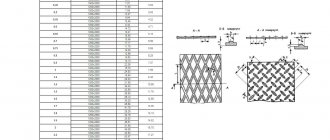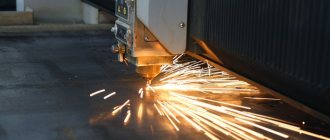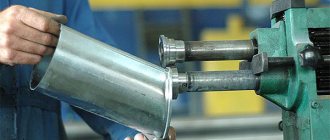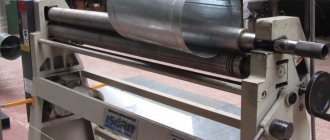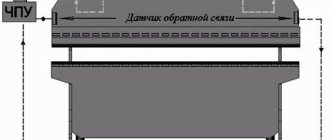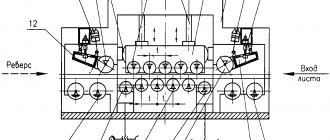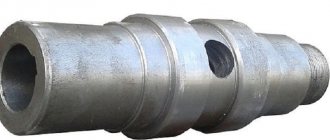Thin sheet metal is used in various fields of activity. The relevance of this material is constantly growing. There are several types of thin sheet metal. It is classified depending on the base and protective coatings used. Manufacturing and processing technology affects the properties, characteristics and applications of the material.
Thin sheet metal
Characteristics and release form
Thin sheet metal has an extensive dimensional grid, but the same cannot be said about the release form. It is produced in three versions: rolls, strips, sheets.
Rolls
Produced by large enterprises. Supplied for sale in ring rolls of different lengths and widths. Take up minimal space. Most metalworking machines are designed to work with coils. They are equipped with special unwinding mechanisms.
Strips
Narrow metal strips that are obtained by cutting steel rolls. Used for the manufacture of long products of small width.
Sheets
Standard release form. Sheets may have different characteristics, which are determined by GOSTs. They are suitable for home work and small-scale production. The main disadvantage of sheets is the large amount of waste during the production of various parts.
Sheets of metal (Photo: Instagram / maxmetall.kg)
Price aspect
It is the cost of services that worries many customers when contacting a particular company. After all, working with metal cannot be cheap. Although many unscrupulous manufacturers offer extremely tempting prices for their products. They just don’t vouch for its quality. Contacting such a company is not fraught with savings, but only with additional costs. And such cooperation will take a lot of time. And without ultimately obtaining the required result.
But with us you eliminate even the slightest problems for yourself. We work with high quality and with a guarantee, and our pricing policy will not leave anyone indifferent. We have the most affordable prices for stainless steel cutting and other services in the entire region, and the cost of any order is calculated individually with each client request. A variety of factors are taken into account, but most often we are talking about the following:
– work is mainly carried out with steel. Although certain decorative items made of metal, brass, copper or bronze may cost more. Affects the price and quality of steel;
- template products will cost the partner less than their analogues, which are made by hand. Having a standard design reduces the cost of work, but an individual sketch allows you to get original products that will not have any analogues;
- the greater the amount of metal spent on the manufacture of one product, the greater the final cost of the finished product;
– we are mainly talking about the delivery of structures and their installation. Although other services are possible. It all depends on the wishes and preferences of a particular customer. We take a comprehensive approach to implementing our obligations and are ready to fulfill all the requirements of each of our partners.
Familiarization with the preliminary price list for metal products is possible at the stage of forming the application. But the exact cost of all the work will be known only after the development of technical documentation is completed. Our prices are transparent and absolutely understandable for everyone. And you can trust us without the slightest fear.
Material and properties
Thin sheet material is made from different types of metal. Each of them has certain properties and characteristics.
Cink Steel
Peculiarities:
- It is used when applied to other parts to protect them from rust.
- Sheets can be processed using hot and cold galvanizing methods.
- The zinc layer reliably protects the metal from corrosion.
The disadvantage is the low strength of the zinc layer.
Galfan coated steel
Galfan is a compound of aluminum and zinc alloy. Aluminum undergoes oxidation, which contributes to the formation of an oxide film. Moisture and oxygen do not pass through it. The oxide film is needed to protect the base and increase the service life of the zinc layer.
Aluzinc coated steel
The protective coating consists of zinc, aluminum, silicon. The active service life of finished products increases 5 times.
Zinc-titanium coated steel
To increase the strength of the protective coating, alloying additives are added to the composition - titanium, copper. Increases ductility and protection against rust formation. When molding and bending, the metal retains its qualities.
Polymer coated steel
In manufacturing, the basis is steel with an aluzinc coating. A phosphating layer and primer are applied on top of it. The finishing coating is polymer.
Steel coils (Photo: Instagram / absolut_metall35)
Kinds
Types of thin sheet steel:
- Roofing. Thickness - 0.5–0.8 mm.
- Tough. Thickness - 0.2–0.5 mm.
Types of tin:
- White. Covered with a layer of tin.
- Black. After production, the surfaces of the sheets turn black.
A layer of tin on tinplate is needed to protect metal surfaces from rust. Roofing steel can be coated with a layer of galvanization or oil paint.
Thin sheet metal and wire are used in various fields of activity:
- Production of metal cassettes - perforated, solid, hollow, filled with thermal insulation.
- Production of ceiling and facade panels.
- Manufacturing of support pillars, metal structures, parapets, lamellas, fence sections, caps.
- Production of window openings and additional elements.
Other areas include the production of housings for machines, instruments, machine tools, cans, dishes, and drainpipes.
Drainpipes (Photo: Instagram / ventilacia_kms)
Manufacturing
The production process includes several stages:
- Initial blanks for the production of sheets are prepared from cast steel. In production they are called slabs.
- The slabs are moved to industrial furnaces, where the billets are heated.
- The heated slabs are moved to the rolling line, where they are rolled out to the required thickness.
- The prepared strips are rolled into rolls and fed to the pickling shop. There they are cleaned of scale and can be processed by pickling or shot peening. Often processing methods are combined.
- The coils are fed to the cold rolled strip. The sheets are joined by welding. The edge is cut and oiling occurs.
- Chemical treatment is carried out.
- The metal is heated in an industrial furnace. Recrystallization occurs.
- The sheets are galvanized.
- Cooling and tempering of steel is carried out.
- When the parts are completely cooled, the steel sheets are straightened to obtain the required flatness.
After the production process is completed, the strips are oiled, rolled up, and sold.
Thin sheet steel is manufactured according to the requirements of GOST 19904-90. This document contains requirements for the characteristics of finished sheets:
- Thickness - from 0.35 mm to 5 mm.
- Length - from 1000 to 6000 mm.
- Width - from 500 to 2350 mm.
For rolls, the length is not regulated.
Industrial oven (Photo: Instagram / xg121)
Sheet stamping
- Sheet stamping
is a type of cold forming in which sheet material is deformed in a cold or heated state. - Sheet stamping produces a variety of flat and spatial parts - from small ones, weighing from fractions of a gram and measuring fractions of a millimeter (seconds hand of a watch), to medium-sized (metal utensils, lids, brackets) and large (facing parts of cars).
- The thickness of the workpiece during sheet stamping is usually no more than 10 mm, but sometimes it can exceed 20 mm; in this case, stamping is carried out with preheating to forging temperatures.
- When sheet stamping is used: low-carbon steels, ductile alloy steels, non-ferrous metals and alloys based on them, precious metals, as well as non-metallic materials: organic glass, felt, celluloid, textolite, felt, etc.
- Sheet stamping is widely used in various industries, especially in the automotive industry, rocketry, aircraft manufacturing, instrument making, and the electrical industry.
- The main advantages of sheet stamping:
- the ability to produce durable, lightweight and rigid thin-walled parts of simple and complex shapes, which are impossible or difficult to obtain by other methods;
- high dimensional accuracy and surface quality, allowing to reduce machining to a minimum;
- comparative simplicity of mechanization and automation of stamping processes, ensuring high productivity (30,000...40,000 parts per shift from one machine);
- good adaptability to the scale of production, in which sheet stamping can be economically beneficial in both mass and small-scale production.
Cold sheet stamping consists of performing separation and form-changing operations in a certain sequence, through which the original blanks are given the shape and dimensions of the part.
Sheet stamping operation
is the process of plastic deformation that provides a characteristic change in the shape of a certain section of the workpiece.
There are dividing
operations in which the stage of plastic deformation necessarily ends in destruction, and
forming
operations in which the workpiece should not be destroyed during the deformation process.
When designing a technological process for manufacturing parts by sheet stamping, the main task is to select the most rational operations and the sequence of their use, which makes it possible to obtain parts with specified performance properties at minimal cost and good working conditions.
All operations are performed using special tools - stamps, which have different designs depending on their purpose. Dies consist of working elements - a matrix and a punch, and auxiliary parts - clamps, guides, stops, etc. The punch is pressed into or enclosed by the deformable metal, and the die encloses the shape-changing workpiece and the punch.
Sheet forming operations
Separation operations
are intended either for obtaining a workpiece from a sheet or tape, or for separating one part of the workpiece from another. Operations can be performed along a closed or open loop.
The separation of one part of the workpiece from another is carried out by a relative displacement of these parts in a direction perpendicular to the plane of the workpiece. This displacement is initially characterized by plastic deformation and ends with destruction.
Segment
– separation of part of the workpiece along an open contour using special machines – scissors or stamps.
It is usually used as a procurement operation for dividing sheets into strips and blanks of the required size.
The main types of scissors are shown in Fig. 15.5.
Rice. 15.5. Schemes of operation of scissors: a – guillotine; b – disk
Scissors with translational movement of the cutting edges of the knife can be with parallel knives, for cutting narrow strips, with one inclined knife - guillotine (Fig. 15.5.a).
The cutting edges in guillotine shears are inclined to each other at an angle of 1...50 to reduce the cutting force. The sheet is fed until it stops, which determines the width of the cut strip B
.
The length of the cut strip L should not exceed the length of the knives.
Processing methods
To produce various parts from thin sheet metal, you need to choose a material processing technology and carry it out in compliance with certain features. Processing methods:
- Flexible. Can be manual or industrial. Manual bending is suitable for bending parts up to 0.6 mm thick. To work with more serious workpieces, you need to use industrial equipment.
- Welding. To process sheets of small thickness, electrodes of small diameter and length are used.
- Cutting. A technological operation that allows you to divide metal blanks into separate parts. There are several types of metal cutting, which differ in the equipment used, technical characteristics of the cuts, capabilities - laser, plasma, water jet, oxygen gas, mechanical.
When cutting metals, it is important to take into account the chemical composition of the alloy, the level of electrical conductivity, sheet thickness, heat resistance, and the presence of protective coatings.
Cold stamping of metal parts
Cold metal stamping technology is a process of processing metals with plastic deformation by pressure, as a result of which the dimensions and shapes of the original material change in the cold state.
Types of cold stamping
Based on the type of workpiece, two types of stamping are distinguished.
Volumetric
It is produced at a temperature below recrystallization and involves the processing of bulk workpieces. Under the influence of the stamp, blanks with the simplest shapes acquire the required configuration.
Volumetric processing can be carried out using two methods:
- Landings. It represents the deformation of the workpiece under repeated impact in the corresponding dies.
- Extrusion. In essence it resembles pressing. The part is formed under the influence of pressure, which is formed as a result of squeezing the workpiece to such a state that the metal flows through the holes of the matrix of a certain shape.
Crafts
Thin sheet metal is used to make various crafts. Shape, size, products are limited by imagination. To work with metal sheets, it is better to use metal scissors rather than a grinder. Power tools can damage protective coatings, causing rust to spread to the cut areas.
Thin sheet metal is used in various industries. The variety of application areas is determined by the presence of different types of coatings, release forms, and standard sizes.
